|
|
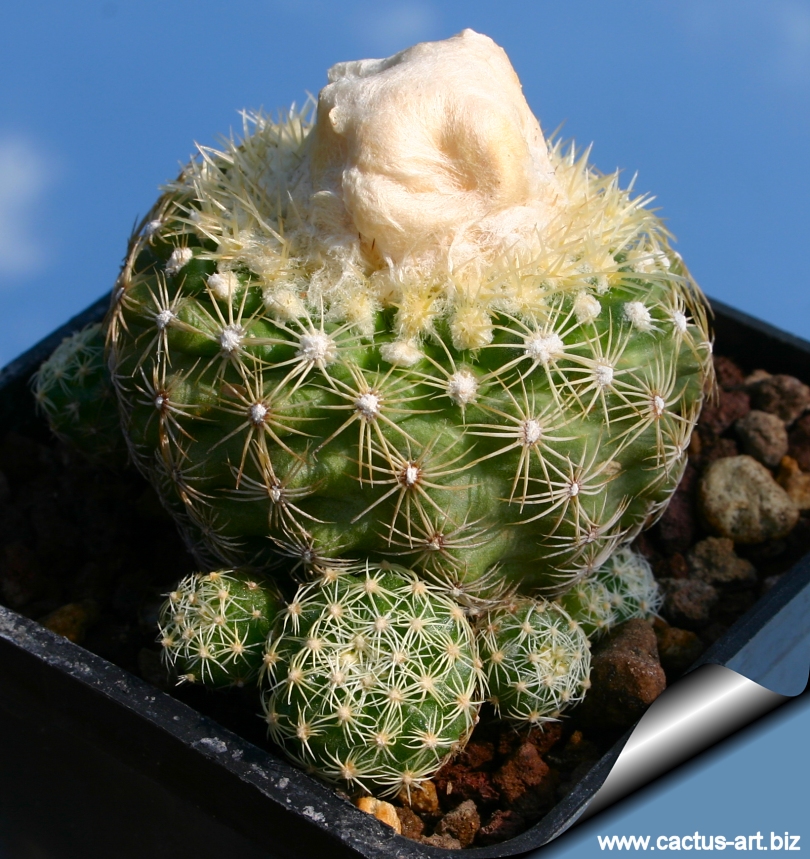
This is one of tiniest cactus which is a true miniature and one of the
smallest species in the genus. It is a mature specimen, and itís only
4/5 cm high and wide. It wonít get any larger. Since it is mature, it
puts all its energy into producing the little woolly top, or cephalium.
|
|
Description: Discocactus buenekeri (also considered just a form of
D. zehntneri) is a
globose-flattened tiny little plant that (in
culture) grows in small groups just like D. boomianus..
Stem: Dull-green 10-20 in diameter and 7-10 cm tall.
Cephalium: Up to 1 cm tall and -4 cm wide, at the apex of the
plant, creamy-white to light-brown with yellow to brownish bristles up
to 2 cm. The size of the cephalium on this specimen is often as
large as the cactus body!
Ribs: About 20, somewhat spiralled, forming nipple-like tubercles
to 1 cm high.
Areoles: Oval, sunken, ca. 8 per ribs.
Radial spines: Interlacing, densely covering the plant, 10 to15
up to 1-2 cm long, pectinate, flexible spines creamy white or
whitish-yellow with dark tips, becoming pale-brown to whitish, recurved
backwards, sitting on the plant like spiders.
Central spines: None.
Flowers: Cream-white, with
heavenly scent, slender funnelform, up to 9 cm long. The position of the
stigma is at the top of the stamens. The bud appears, grows and
opens all within 24 hrs. Each flowering lasts only one night, but that
night it produces many flowers.
Blooming season: This species usually blooms in April, May, or
June or as late as August.
Fruit: Club-shaped, white.
|
|
 |
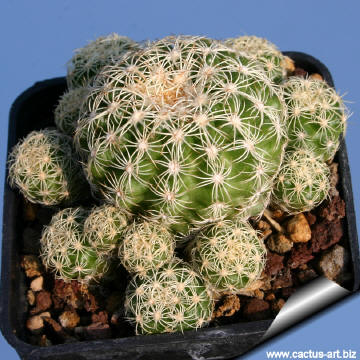 |
|
. |
|
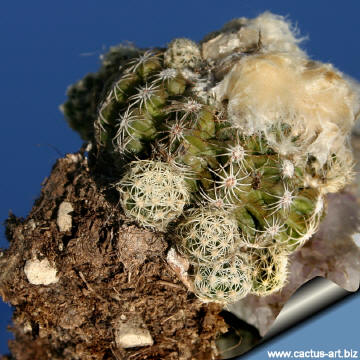 |
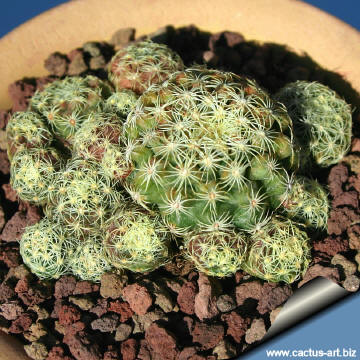 |
|
This plant is part of the D. zehentnari complex which comprises several variable subordinates taxa,
but not all are universally recognized. Some
authorities recognize only the following :
subsp. zehntneri Usually globose and
completely covered in white thin, needle-like spines, the flower is
about 3 cm long and the fruit are red (Origin: Sentocť)
subsp. horstiorum = subp zehntneri (Origin: near
Minas do Mimosa, Moreno, Sierra do Espinahaco,
Bahia )
subsp. boomianus Usually disk -shaped, with dark tipped
yellowish spines, the flowers are up to 9 cm long (Origin: Sierra do
Espinahaco)
subsp. buenekeri this species does share the complex
commonality of tuberculate ribs and basal offsetting, but its white,
club-shaped fruit does not fit with the dark red , much elongated and
slender fruit of the other taxa.
subsp. araneispina has flexible,
interlacing spider-like spines that cover the plant.
subsp. albispina
|
|
Photo of conspecific taxa, varieties, forms and cultivars of
Discocactus zehntneri.
Advertising
|
|
|
|
|
Family:
Cactaceae (Cactus
Family) Discocactus buenekeri
W.R.Abraham 1987
Accepted
Scientific name: Discocactus
zehntneri Britton & Rose 1922
Subfamily: Cactoideae
tribe: Trichocereeae.
Origin: Bahia Southern Brazil
(South America)
Habitat: It is native to Brazilís tropical forests and grows
on quartz substrates.
Conservation status: Listed in
CITES appendix 1.These species are
threatened with extinction.
Common English Names include: Squash Cactus, Moon cactus.
Synonyms (of Discocactus zehentneri):
- Discocactus zehntneri ssp. albispinus
(Buining et Brederoo) P.J.Braun & Esteves 1995.
- Discocactus zehntneri ssp. boomianus
(Buining & Brederoo) N. P. Taylor & Zappi 1991
- Discocactus zehntneri subsp. araneispinus
(Buining et Brederoo) P.J.Braun & Esteves 1995.
- Discocactus zehntneri ssp. horstiorum
- Discocactus zehntneri var. horstiorum
- Discocactus zehntneri ssp. buenekeri
|
|
|
|
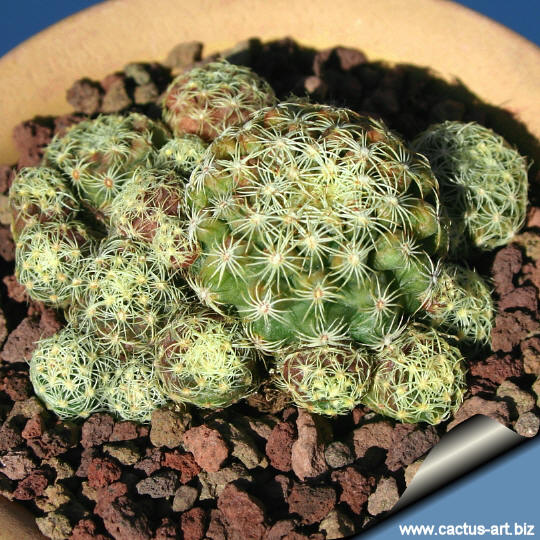
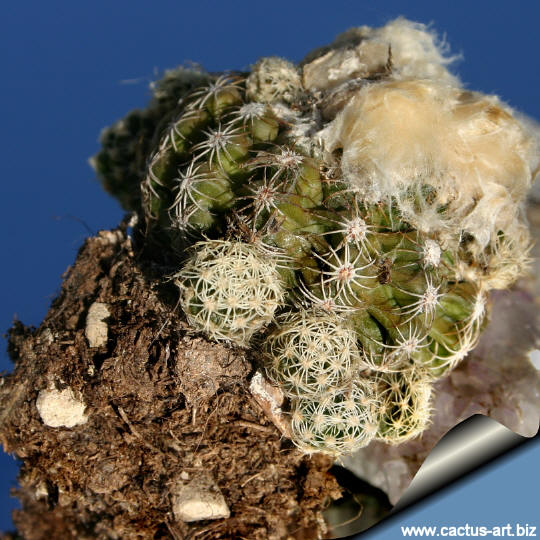
The woolly cephalium is from where the flowers emerge, and the flowers
can literally sneak up on you! They seem to pop up in just a few hours
and bloom when the sun goes down. The flowers have a powerful gardenia-like
scent that permeated the air.
Cultivation: Discocactus
buenekeri is one of the easiest species of the genus to grow,
but even so it isn't a plants for beginners, in fact collectors consider
the Discocactus to be rarities with requires skilful cultivation.
it is rather difficult to grow and frost tender, it canít stand cold, or
even fairly cool temperatures and should be kept at above 15į C if grown
on its own roots (8įC if grafted). Need full sun or afternoon shade.
They are slow growing and very rot prone when kept on their own roots
and though they canít endure long stretches of total dryness, too much
water will rot them, as their weak root systems tend to be inefficient
at sucking up water from wet soil. They generally resent being repotted
and can take a long time to establish. When grown to maturity, however,
it possess an exotic look shared by no other cacti, and it generally
attract a lot of attention.
Propagation: Seed or
cuttings. Young seedlings are generally grafted on a low stock to keep
the plant in a good shape.


|
|